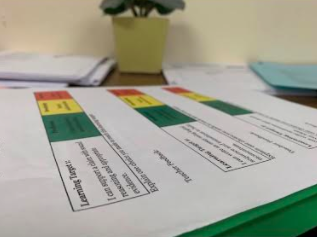Targets-Based Grading Unveiled with Mixed Reactions

November 24, 2019
Targets-based grading replaced letter grading at NHS ahead of the 2019-’20 school year.
“Really it was a district decision that ultimately said, ‘let’s move forward with this’ and it’s been a three-year process to get it to the classrooms,” Principal Brian Wunderlich said.
Targets-based grading, also referred to as standards-based grading, aims to clarify content and student expectation by establishing “targets.” Some targets will be assessed once, typically those specific to a unit of study, while “trending targets” will be assessed progressively throughout the semester. In turn, the targets are graded as green, yellow or red instead of A, B, C, D and F, according to Principal Wunderlich.
Two-and-a-half months into the inaugural year, and opinions are a mixed bag. Students, primarily, have expressed skepticism.
A survey titled, “Targets-Based Grading,” circulated via an administrative-approved post on Schoology this past week details student’s early reactions of the system. Of the 301 responses, 102 students (34 percent) rated the targets-based system as a zero on a 0-10 scale, while only 17 students voted for an eight or higher. Moreover, 87.7 percent of students stated they prefer the letter-system over the targets-based.
The free-response section of the survey took an unexpected turn. Students were asked to explain which grading system they prefer, leading to a mix of personal anecdotes and strong opinions in favor of each system.
“The standards are up for teacher interpretation. The letter system had a clear way to grade,” one student said.
“Target-based learning provides a better assessment of what students are learning, although I highly dislike the organization behind the targets,” another student said.
Administrators, in response, preach patience.
“The learning is a process . . . our classes that have piloted this and done it for a couple of years, our kids about six, seven and eight weeks into it were like, ‘I don’t get this.’ By about 11 or 12 weeks they were like, ‘This is awesome.’ I know what I needed to do,” Wunderlich said.
Social studies teacher Kert Dietrich shares that opinion. “It’s new; it’s going to take some time to learn it, especially how the color system converts to a letter grade,” Dietrich said.
A line dividing perspectives appeared, rather distinctly. But administration anticipated the growing pains.
“Students and parents – and truthfully teachers and administrators, too – were used to a grade being, ‘right now I’m getting an A.’ I think the thing we have to get through, and I think it will get better after we get a full semester under our belts, is that learning is a process,” Wunderlich said.
This system will continue to be evaluated throughout the year with students, teachers and community members encouraged to voice opinions and provide feedback.

